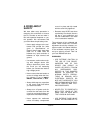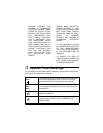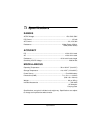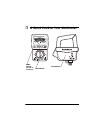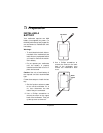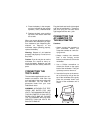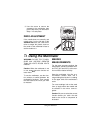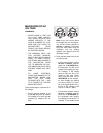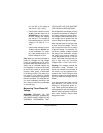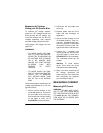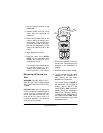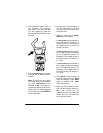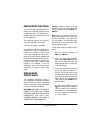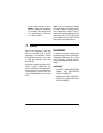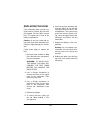
12
Using the Multimeter
to 2, the AC or DC voltage is
100 volts (2
×
50 = 100V).
• If the function selector is set to
15 DCV
, read the lower line of
ACVA/DCVA
on the multime-
ter then multiply the reading
you see by 5. For example, if
the needle points to 2, the DC
voltage is 10 volts (2
×
5 =
10V).
• If the function selector is set to
15 ACV
, read the
AC15V
line
on the multimeter. For exam-
ple, if the needle points to 10,
the AC voltage is 10 volts.
Hint:
When you use the multimeter to
probe for a voltage in a high-voltage
circuit, we recommend you do not try
to position both test leads at once. In-
stead, use an insulated alligator clip
(not supplied) to clamp one test lead
to the circuit's neutral or ground lead
(usually a bare, green, or white lead
in AC wiring circuits). Then place your
free hand in your pocket or behind
your back and probe for voltages with
the other test lead. This helps prevent
you from accidentally touching a hot
wire, since you need only concentrate
on one test lead.
Measuring Three-Phase AC
Voltage
WARNING:
BECAUSE OF THE
DANGERS INHERENT IN MEASUR-
ING THREE-PHASE CIRCUITS, WE
STRONGLY RECOMMEND THAT
YOU DO NOT USE THIS MULTIME-
TER FOR SUCH APPLICATIONS.
We designed this multimeter primarily
to measure household AC voltages. If
you want to measure 3-phase, line-to-
line voltages, please note that the ac-
tual voltage can be greater than the
circuit’s rated line-to-ground voltage.
Most 3-phase power circuits are rated
by their
line-to-line
voltage. This volt-
age is higher than the line (or phase)
to ground voltage. To determine if a
line-to-line 3-phase voltage exceeds
the rating of this multimeter, multiply
the rated line-to-ground voltage by
1.732 (the square root of 3). For ex-
ample, if the rated line-to-ground volt-
age is 300 volts, the line-to-line
voltage is 300
×
1.732 = 519.6 V AC.
Warning:
This voltage exceeds the
multimeter’s rating. Therefore, you
should not connect the multimeter to
this circuit or to any equipment con-
nected to the circuit. Doing so could
present a dangerous shock hazard to
you, and could also damage the mul-
timeter.
If you do not know why there is a volt-
age difference, you should not be
working on three-phase power cir-
cuits. These circuits are generally ex-
tremely powerful and very dangerous.
Special safety equipment should be
worn when working around these
dangerous circuits.



